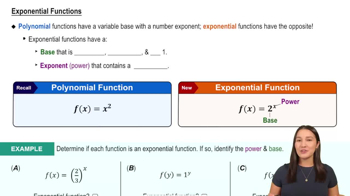Table of contents
- 0. Functions7h 52m
- Introduction to Functions16m
- Piecewise Functions10m
- Properties of Functions9m
- Common Functions1h 8m
- Transformations5m
- Combining Functions27m
- Exponent rules32m
- Exponential Functions28m
- Logarithmic Functions24m
- Properties of Logarithms34m
- Exponential & Logarithmic Equations35m
- Introduction to Trigonometric Functions38m
- Graphs of Trigonometric Functions44m
- Trigonometric Identities47m
- Inverse Trigonometric Functions48m
- 1. Limits and Continuity2h 2m
- 2. Intro to Derivatives1h 33m
- 3. Techniques of Differentiation3h 18m
- 4. Applications of Derivatives2h 38m
- 5. Graphical Applications of Derivatives6h 2m
- 6. Derivatives of Inverse, Exponential, & Logarithmic Functions2h 37m
- 7. Antiderivatives & Indefinite Integrals1h 26m
- 8. Definite Integrals4h 44m
- 9. Graphical Applications of Integrals2h 27m
- 10. Physics Applications of Integrals 2h 22m
2. Intro to Derivatives
Derivatives as Functions
Problem 3.3.89
Textbook Question
Calculator limits Use a calculator to approximate the following limits.
lim x🠂0 e^3x-1 / x
 Verified step by step guidance
Verified step by step guidance1
Step 1: Recognize that the limit \( \lim_{x \to 0} \frac{e^{3x} - 1}{x} \) is an indeterminate form of type \( \frac{0}{0} \). This suggests that L'Hôpital's Rule might be applicable.
Step 2: Recall L'Hôpital's Rule, which states that if \( \lim_{x \to c} \frac{f(x)}{g(x)} = \frac{0}{0} \) or \( \frac{\infty}{\infty} \), then \( \lim_{x \to c} \frac{f(x)}{g(x)} = \lim_{x \to c} \frac{f'(x)}{g'(x)} \), provided the limit on the right exists.
Step 3: Differentiate the numerator and the denominator separately. The derivative of the numerator \( e^{3x} - 1 \) is \( 3e^{3x} \), and the derivative of the denominator \( x \) is \( 1 \).
Step 4: Apply L'Hôpital's Rule to the original limit: \( \lim_{x \to 0} \frac{e^{3x} - 1}{x} = \lim_{x \to 0} \frac{3e^{3x}}{1} \).
Step 5: Evaluate the new limit: \( \lim_{x \to 0} 3e^{3x} \). As \( x \to 0 \), \( e^{3x} \to e^0 = 1 \). Therefore, the limit simplifies to \( 3 \times 1 = 3 \).
 Verified video answer for a similar problem:
Verified video answer for a similar problem:This video solution was recommended by our tutors as helpful for the problem above
Video duration:
5mPlay a video:
Was this helpful?
Key Concepts
Here are the essential concepts you must grasp in order to answer the question correctly.
Limits
A limit is a fundamental concept in calculus that describes the behavior of a function as its input approaches a certain value. It helps in understanding how functions behave near points of interest, including points of discontinuity or infinity. In this case, we are interested in the limit of the function as x approaches 0.
Recommended video:

One-Sided Limits
Exponential Functions
Exponential functions are mathematical functions of the form f(x) = a * e^(bx), where e is the base of natural logarithms. They are characterized by their rapid growth or decay and are essential in various applications, including calculus. The expression e^(3x) in the limit indicates that we are dealing with an exponential function, which will influence the limit's value as x approaches 0.
Recommended video:

Exponential Functions
L'Hôpital's Rule
L'Hôpital's Rule is a method used to evaluate limits of indeterminate forms, such as 0/0 or ∞/∞. It states that if the limit of f(x)/g(x) results in an indeterminate form, the limit can be found by taking the derivative of the numerator and the derivative of the denominator. This rule is particularly useful in this problem, as substituting x = 0 directly leads to an indeterminate form.
Recommended video:
Guided course

Power Rules
Related Videos
Related Practice




